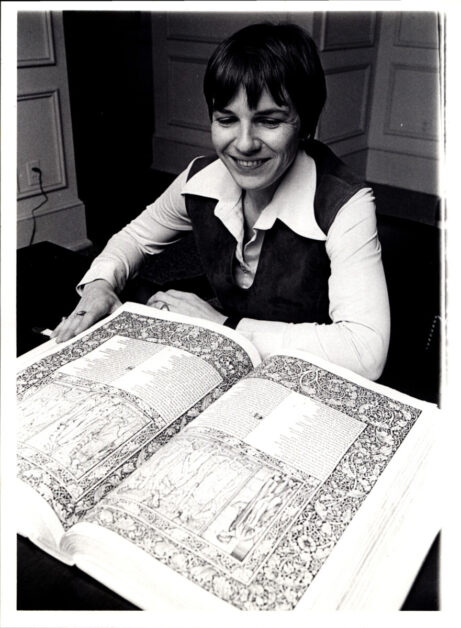by Emmy Mills

The Special Collections and University Archives Division (as it became known in 1972) began as a closed stack area on the third floor of Jackson Library. The Circulation Department (where I was a staff member from 1967 to 1971) was responsible for materials held there. While I was happy with my responsibilities, there was no room for advancement without a library degree. I was encouraged to apply to the University of Illinois, which I did. With my earlier background in art (MFA, UNCG, 1965) I had found the area of librarianship of which I wanted to be a part. It seems like magical thinking that this position would happen, but it did. The timing was right, the need urgent, (and it was before the days of search committees and national searches). I wrote an argument for the new position while still in Illinois and was rewarded with an offer before I finished my degree work.
With my new library spurs, I returned in the Fall of 1972 eager and full of ideas. I inherited that closed stacks cage and given the key to the realm with no telephone, no copy machine, no card catalog or shelf-list and a view of the flat, tarred roof.
A small, rather unfocused collection of rare books called the “Gold Star Collection”, was there along with the College Collection of school-related printed materials and photographs, student scrapbooks, the “Pine Needles” college yearbook and other college publications. These were housed there along with items deemed too fragile or too controversial to be kept in the open stacks of the library, (e.g., Playboy magazine and foreign “art” periodicals). This was also a storage area for materials no one had dealt with such as the transferred papers of the first three Presidents of the college, Charles D. McIver, Julius I. Foust and Walter C. Jackson. Two retired librarians worked a few hours a week on the College Collection, organizing vertical file items and photographs documenting the history of the school. Student help came later, and it wasn’t until 1974 that Betty Carter arrived to help take on the University Archives.
The fun began day after Labor Day in 1972, my first official day on the job. I felt a bit overwhelmed: Why is this (or that) here? Are there funds for conservation of damaged and deteriorating materials? Will I have a budget? After meeting and talking with other rare book librarians and archivists in North Carolina institutions, it was obvious to me that UNCG has an opportunity to complement programs of study at UNCG and establish collection efforts unique to our institution. Cooperative collection development, reorganization and conservation of materials were major priorities in the 1970s. We needed collection development policies for book collection and an updated archives records schedule to guide the transfer of university generated documents and publications.
Over the years specialist booksellers were helpful with their depth of knowledge. I worked closely with those who had expertise in subject areas that would strengthen our existing collections. Those who dealt in out-of-print materials were most generous with their knowledge. They also had amusing and amazing stories to tell and had locks on book-world gossip with they shared over leisurely drinks and dinners. Many of them from London to California were over-night guests in our home. I took lessons from these seasoned professionals even when I didn’t take their advice!
Clearly, UNCG has obvious strengths including an uncatalogued collection of books by, about and of interested to women (The Anthony M. Ludovici collection purchased in the 1960s), the early children’s books (part of the large Lois Lenski collection), and books illustrated by famous 20th century artists. To build on some of these strengths seemed obvious. A nascent women’s studies program supported expansion of our already impressive collections of historical works relating to women.
Other areas were less well defined. Many out-of-scope and non-rare items were transferred to the general collection. An early inventory revealed some items missing or mutilated. We discovered in the ‘70s that some enterprising, knowledgeable individuals had left the library with more than they had when they entered. Some titles were recovered over time but at great expense of replacement or restoration. Luckily, we had private funds that enabled replacement of some losses and to repair damaged materials. Security improved rapidly!
Throughout the 1970s, we refined and expanded collection development guidelines. This early period saw expansion of our cello music and women’s history materials. Rounding out themes of the art of the book included selected English and American private presses of the 19th and 20th centuries. Collections were heavily used by art, music and dance.
The decade also benefited from healthy private funding sources when interest rates saw historic highs and Friends of the Library donations brought good annual returns. To celebrate the U.S. Bicentennial, the Washington handpress was restored with help from the Smithsonian and the former Library Director, Charles M. Adams. Samples of small keepsakes were printed for the occasion. Speaking engagements to book clubs and literary groups resulted in greater public interest in Special Collections in the decade of the 1970s. It was a busy time of growth and wider exposure for researchers on campus and from other institutions.
-Emilie (Emmy) Mills ’62, WCUNC; ’65, MFA, UNCG; ’72, MSLS (U. of Illinois)